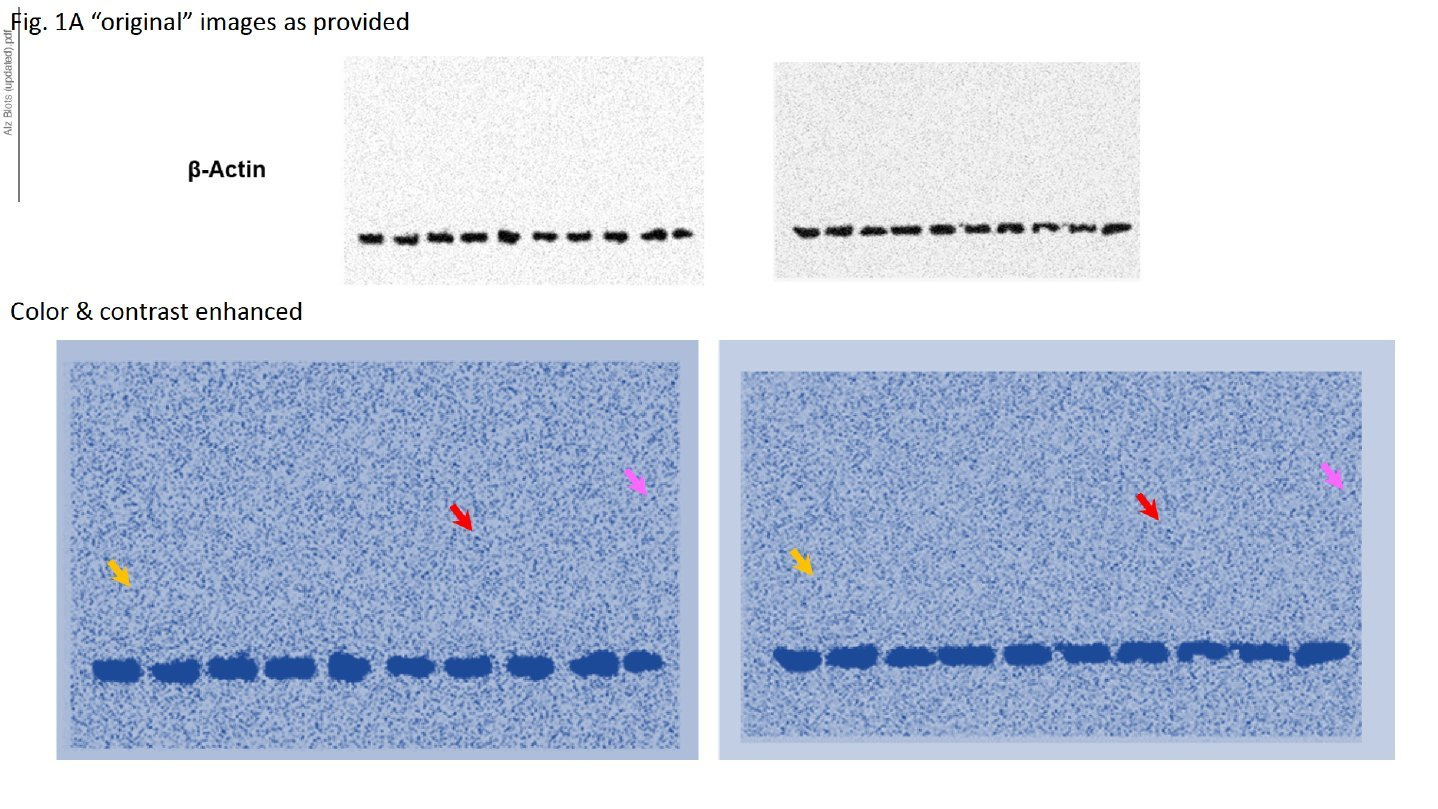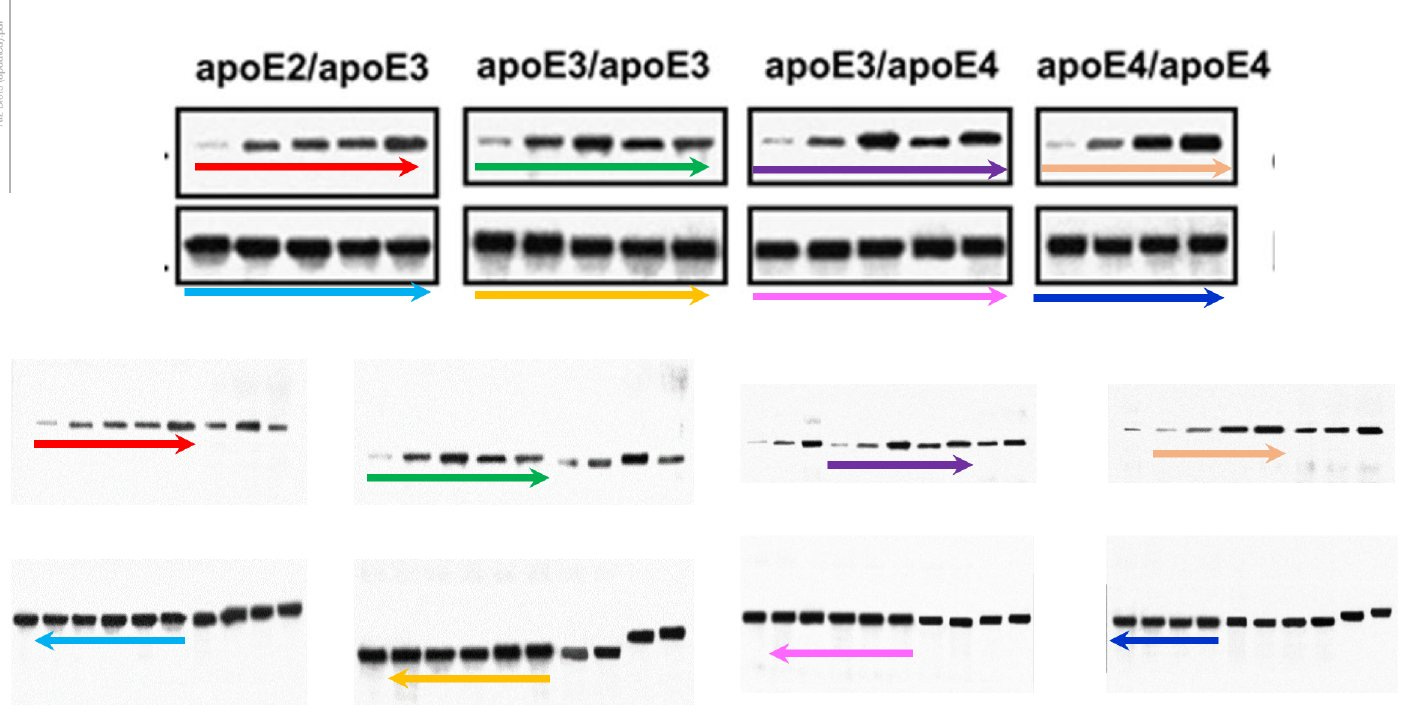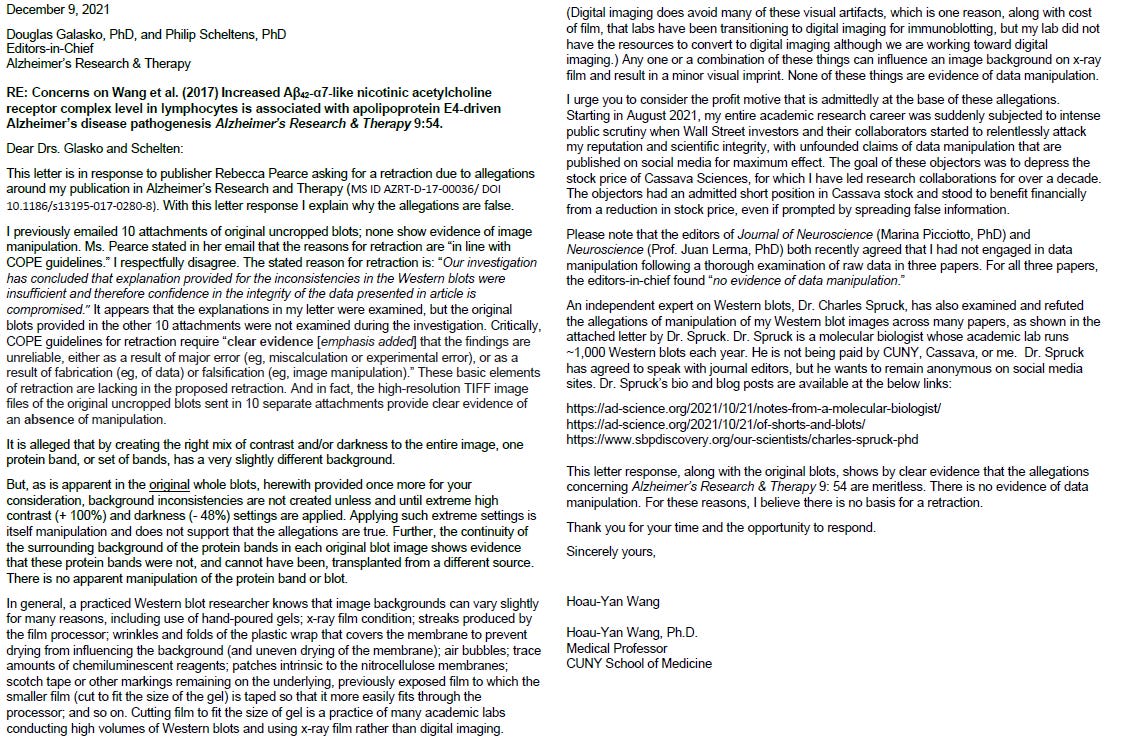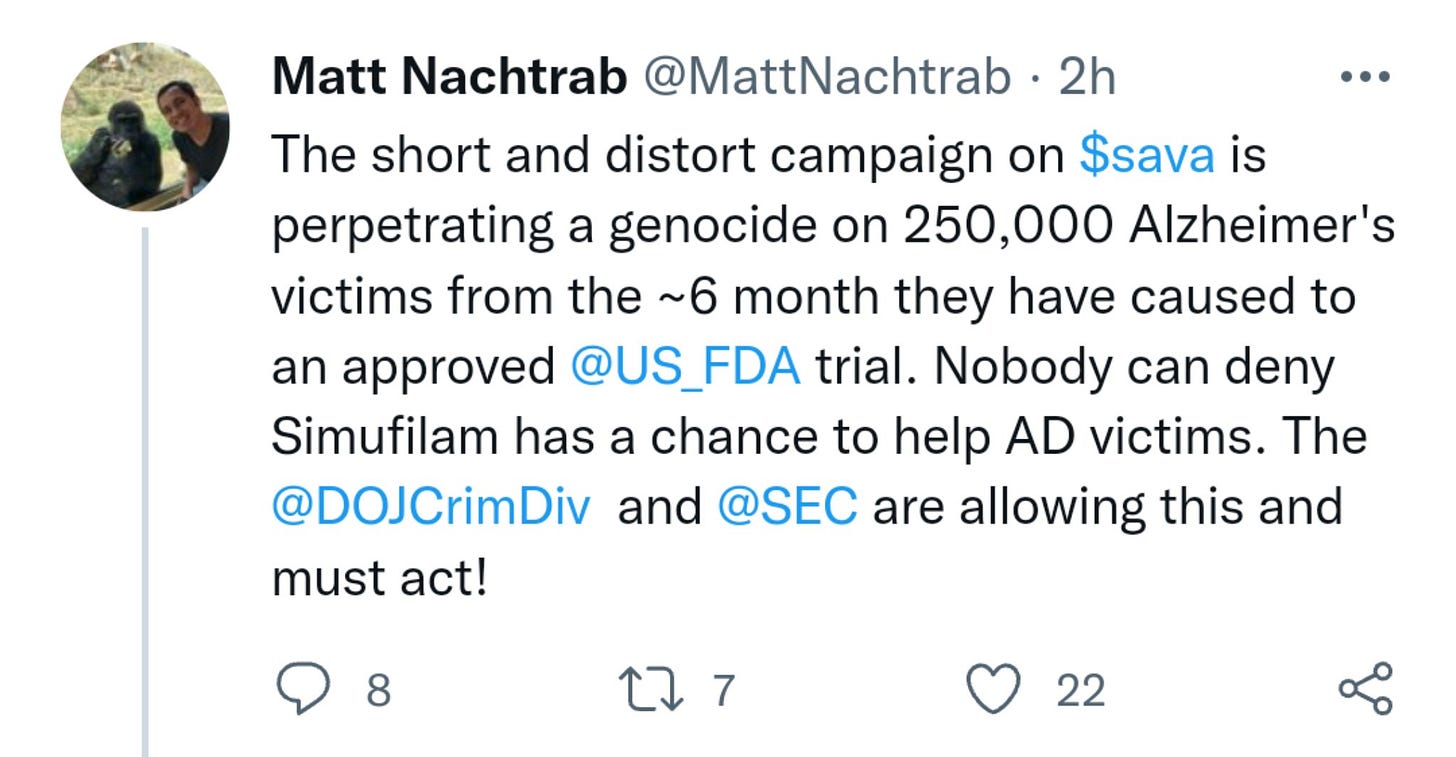Memory Games, Part II: “The Editors-in-Chief Have Retracted This Article”
Lifting the Veil on Dubious Data
In the first part of this series on Cassava Sciences and their troubled drug candidate, simufilam, I closed with the observation that no credible raw data has yet to materialize from the lab of Dr. Hoau-Yan Wang, a lab that is for all intents and purposes also the lab of Cassava Sciences. It’s unsurprising, if disappointing, that Cassava declined to furnish any data for the public. Given the proactive nature of their public communications, we could reasonably expect them to paint the walls with western blots if they could—imagine a more simple way to give your adoring legion of pious investors everything they could possibly ask for! But unless you’re hand to god certain about their authenticity, a better (if far more pessimistic) strategy is to work behind the scenes where there are as few eyes as possible on the goings on.
The wrinkle, it turns out, is that Dr. Wang is an employee of a public university in New York State, and there are certain laws, namely Freedom of Information Law (FOIL), that allow people to request records from public employees. Now, it would be pretty bad if what these emails entailed was a series of attempts to deflect and deny the allegations while failing to provide any actual data. And we do see exactly this, for example in an exchange between Dr. Lindsay Burns, chief neuroscientist as Cassava, and the Editor in Chief of IBRO Neuroscience, Juan Lerma, where Burns claims, unbelievably, that they are “looking for the original blots in backup drives, since the original melted years ago.” Meanwhile, she provides links to a blog written by a group of Cassava investors and offers a sort of character witness in Charles Spruck, the biochemist quoted in the New York Times article discussed in the first part of this series.

It’s bad, but somehow it gets much, much worse. In June 2022, Alzheimer’s Research and Therapy made the editorial decision to retract a 2017 paper by Wang with the explanation that “the authors have provided the raw data, which have been assessed by independent experts and deemed insufficient to address the concerns.” Editorial retraction is a fairly drastic measure, particularly given that the investigation at CUNY School of Medicine was (and still is) ongoing, and an Expression of Concern provides the journal a bit of cover in the interim. There have in fact been seven Wang retractions at time of writing, and a few additional Expressions of Concern, but I’ll focus on the paper from Alzheimer’s Research and Therapy for now because FOIL documents have provided a glimpse into what transpired behind the scenes.
The editors at Alzheimer’s Research and Therapy reference the receipt of raw data in their retraction notice. No actual raw data has emerged, so for a time it was anyone’s guess what the editors might’ve received from Wang that caused them to issue the retraction. Then, a few emails turned up in a FOIL document between research integrity officers at Springer Nature, the publisher of Alzheimer’s Research and Therapy, and Wang. In these emails, it appears that Wang provided data which he claimed was original, only for the editors to apply a series of straightforward forensic techniques and uncover a handful signs of data tampering, including, for example, regions of highly correlated background noise.

There are ten attachments to the FOIL emails containing blots that were scrutinized by the editors at Alzheimer’s Research and Therapy, and even the most basic techniques described by the HHS Office of Research Integrity forensic tools can capture a wealth of signatures for manipulation. Along with the regions of overlapping background noise, there are rectangular blocks of higher saturation and dark edges beyond the natural image boundaries, both signals of potential copy/pasting of data, and blots that were actually in the reverse orientation that they appeared in the paper!

When all said and done, the editors had seen enough to move forward with a retraction prior to the outcome of the CUNY investigation. An email from Rebecca Pearce, an Executive Publisher at Springer Nature, leaves no wiggle room in the publisher’s decision to retract the paper. From all appearances, it was an open and shut case.

There is one last email from Wang to the editors of Alzheimer’s Research and Therapy before the trail goes cold, but it’s a telling one. Along with references to a pair of other journals that had “cleared” Wang (we’ll cover these later, but for now just note that one reversed course upon further examination and the other went radio silent after additional concerns were documented), we once again see what looks like an orchestrated attempt by Dr. Burns (who was not an author on this paper) and Wang to use the Cassava investor blog (ad-science.org) and Charles Spruck as interference when original data cannot be produced. Wang also appears to misunderstand well known forensic techniques for detecting image tampering, describing contrast modification as “itself manipulation” and therefore not admissible. Rather than grapple with the reality of the forensic analysis that Springer Nature performed, Wang defaults to an argument that has ingratiated itself with Cassava supporters—that any possible explanation he can conjure from thin air shifts the burden of proof back onto those who have documented the concerns.

Changes in background intensity could be due to plastic wrap or scotch tape; trace chemiluminescence reagents could cause background correlation; the blots appear reversed because…? Well, he doesn’t quite get around to addressing that one, but there is assuredly something in the realm of our infinite experience or imagination that could explain it. Never mind that there should be a real, actual gel with some plastic wrap and scotch tape on it—this paper is from 2017, well within reasonable data retainment expectations—or, at the very least, a few other high resolution scans that can independently confirm Wang’s exculpatory musings without themselves raising entirely new sets of concerns.
What appears to have transpired at Alzheimer’s Research and Therapy is incredibly troubling. The dots are not particularly difficult to connect between requests for original data, representations made by Wang that the data he provided was original, and finally a determination by the journal that the data provided by Wang was not in fact original in any sense of the word. This kind of conduct is serious enough that mere equivocation after the fact simply doesn’t cut it—the burden is on Wang to produce something far more compelling than imagined excuses and links to Cassava investor blogs. What’s even worse, this kind of deception is actually a pattern established across multiple papers by Wang and Burns, most notably in the Journal of Neuroscience and IBRO Neuroscience. What transpired at those journals deserves its own article, one that I hope to write in the near future, though I may delay it since there are certain aspects that will likely serve better as a retrospective once CUNY and various government agencies have finished their inquiries.
Before closing this chapter, however, I do want to make note of the increasing vitriol coming from people with publicly disclosed financial interest in the success of Cassava Sciences. Much like the now infamous meme stocks, there is an insular group of people whose devotion to Cassava coupled with their unwillingness to think critically about their investment thesis engenders a feeling amongst them that their utter nastiness is somehow in service of a greater good. It is not. Most recently, this collective psychosis has manifested in the form of accusations that scientists such as myself (and notably Elisabeth Bik, who bears the brunt of their heinous hatemongering) are engaging in a genocide against Alzheimer’s patients because of our vocal concerns about Cassava’s science and our willingness to call out what I described in this post.
This is not only wrong, it is an unacceptable discourse. We now know from emails in these FOIL requests that some of these people have had direct contact with officers at Cassava Sciences, which is why the company was tuned into the investor blog in the first place. Cassava even had to issue an emergency 8-K last week when some of these investors started making claims that an ongoing SEC probe into the company had concluded, addressing the rumors directly by stating that they have not received a termination letter regarding the probe.
This kind of animosity is unhealthy, but the energy pouring into it would be better spent asking why the people who have actual control over this situation—the scientists who performed the experiments—appear incapable or uninterested in making a good faith effort to come up with any real evidence that they performed the science. It is not a burdensome ask for them. If you’re searching for answers beyond what had to be pried from closed containers via FOIL requests, start there.


